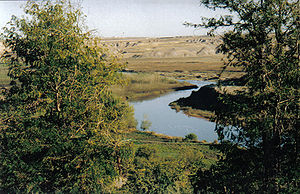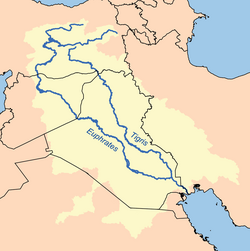Tigris
From Wikipedia, the free encyclopedia.
The Tigris (Old Persian: Tigr, Aramaic Assyrian: Deqlath, Arabic: دجلة, Dijla, Turkish: Dicle; Hebrew: חידקל; biblical Hiddekel) is the eastern member of the pair of great rivers that define Mesopotamia, along with the Euphrates, which flows from the mountains of Anatolia through Iraq. (Indeed, the name "Mesopotamia" is a Greek translation from the Old Persian Miyanrudan, which means "the Land between the Rivers". Bethnahrin is the Assyrian word for the area.). The original Sumerian name was idigna, which can be interpreted as "the river that goes", contrasted to its neighbor, the Euphrates, whose leisurely pace caused it to deposit more silt and build up a higher bed than the Tigris. The Greek name tigris comes from the Old Persian word for "tiger" and means "the fast one". It might also be argued to come from Kurdish too. In Kurdish "Tir" means arrow. This means that the river is quick and fast like an arrow. In Kurdish "Derzi" means needle, meaning that the river is long and straight like a needle (Derzi-Terzi-Tirzi-Tigris). Another name for this watercourse, used from the time of the Persian Empire, is Arvand, which has the same meaning. Today, the name Arvand refers to the lower part of the Tigris (ie, Arvand/Shatt al-Arab) in Persian.
The Tigris is approximately 1,800 km (1,150 miles) long, rising in the Taurus Mountains of eastern Turkey and flowing in a generally southeasterly direction until it joins the Euphrates near Al Qurna in southern Iraq. The two rivers together form the Shatt al-Arab waterway, which empties into the Persian Gulf. The river is joined by many tributaries, including the Diyala and Zab.
Baghdad, the capital of Iraq, stands on the western bank of the Tigris, while the port city of Basra straddles both the Tigris and the Euphrates. In ancient times, many of the great cities of Mesopotamia stood on or near the river, drawing water from it to irrigate the civilization of the Sumerians. Notable Tigris-side cities included Nineveh, Ctesiphon and Seleucia, while the city of Lagash was irrigated by Tigris water delivered to it via a canal dug around 2400 BC. Saddam Hussein's home town of Tikrit is also located on the river and derives its name from it.

The Tigris has long been an important transport route in a largely desert country. It is navigable as far as Baghdad by shallow-draft vessels, but rafts are required for transport upstream to Mosul. River trade declined in importance during the 20th century as the Basra-Baghdad-Mosul railway and roads took over much of the freight traffic.
The river is heavily dammed in both Iraq and Turkey, in order to provide water for irrigating the arid and semi-desert regions bordering the river valley. Damming has also been important for averting floods in Iraq, to which the Tigris has historically been notoriously prone following snowmelt in the Turkish mountains around April. Recent Turkish damming of the river has been the subject of some controversy, both for its environmental effects within Turkey and its potential to reduce the flow of water downstream.
See also
- Assyria
- Cradle of Humanity (Cradle of Civilization)
- Euphrates
- Ilisu Dam Campaign campaign against a planned dam on Tigris in Turkey
- List of places in Iraq
- Tigris-Euphrates alluvial salt marsh



